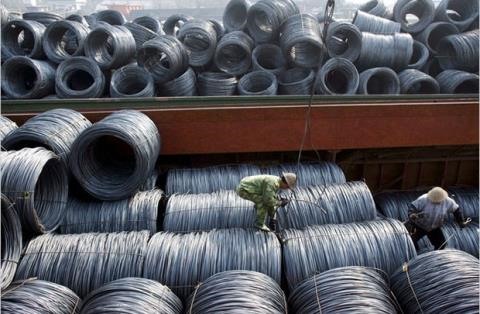 Economy
Economy

Though Việt Nam possesses huge amounts of iron ore, there is a serious shortage of steel for the mechanical engineering industry and defense industry, the Ministry of Industry and Trade’s Heavy Industry Department Director Trương Thanh Hoài told online newspaper news.zing.vn on Monday.
 |
| By 2020, Việt Nam will face a shortage of about 15 million tonnes of crude steel and up to 20 million tonnes by 2025.— Photo baodatviet.vn |
HÀ NỘI — Though Việt Nam possesses huge amounts of iron ore, there is a serious shortage of steel for the mechanical engineering industry and defense industry, the Ministry of Industry and Trade’s Heavy Industry Department Director Trương Thanh Hoài was quoted by the online newspaper news.zing.vn on Monday.
This is the paradox of Việt Nam’s steel production, causing a trade deficit and affecting the stability of the macro economy.
Việt Nam’s steel industry has great potential but the industry’s development is not synchronised. For example, hot rolled coil (HRC) and alloy steel cannot be produced domestically, therefore, Việt Nam still has to import a large quantity of these raw materials and semi-finished products, he said.
“The country’s ship-building industry is depending entirely on imported steel,” Hoài said, adding that Việt Nam has spent billions of dollars to import steel annually, reflecting the huge domestic demand of a developing country requiring infrastructure and undergoing rapid urbanisation.
By 2020, Việt Nam will face a shortage of about 15 million tonnes of crude steel and up to 20 million tonnes by 2025, Hoài said, adding that the country must develop steel complex projects to produce all kinds of steel to serve the country’s mechanical industry.
According to the Việt Nam Steel Association (VSA), steel imports in 2016 surpassed the country’s total steel production, reaching 17.5 million tonnes, up 16.8 per cent year-on-year, of which the amount of consumption reached 15.3 million tonnes, up 23.7 per cent compared to 2015.
VSA vice chairman Nguyễn Văn Sưa warned that Việt Nam risks being flooded by imported steel products, adding that strong rises in imports are hindering the growth of domestic producers.
According to the General Department of Customs’ statistics, Việt Nam spent US$11 billion importing over 22 million tonnes of steel and iron products in 2016, an increase of 18.4 per cent and 7.2 per cent in volume and value, respectively, against the same period in 2015.
Imported steel from China amounted to more than 10 million tonnes, worth nearly $4.5 billion, and accounting for 50 per cent of Việt Nam’s imported steel. The figures represent year-on-year increases of 14 per cent in volume, and 7 per cent in value, he said.
Japan, the Republic of Korea are the other major steel exporters to Việt Nam, making up 20 per cent of the country’s total imported steel. Import numbers from Japan and South Korea were 2.6 million tonnes and 1.8 million tonnes, worth $1.2 billion and $1 million, respectively
Meanwhile, Việt Nam exported approximately 3.9 million tonnes of steel of different types to traditional ASEAN and US markets. Sưa said that last year, steel export faced many difficulties due to trade defence lawsuits filed by the US, Canada, India, Thailand and Malaysia.
"China steel massively penetrating into Việt Nam is mainly produced at industrial zones and factories located in the country’s coastal region. This type of steel is competing with local steel as sea transport costs are very cheap, not to mention the convenient transport conditions,” Hoài said.
Hoài said 18 Vietnamese steel companies had petitioned the Government and the Ministry of Industry and Trade to extend the scope of application of trade defense tax, tightly controlling steel imports to prevent trade fraud and tax evasion.
In March 2016, the Ministry of Industry and Trade issued a decision to apply additional tariffs on imported steel products as a temporary safeguard against inexpensive imports that were allegedly threatening the domestic industry. Temporary safeguard duties of 23.3 per cent were imposed on steel billets and 14.2 per cent on long steel products for a maximum of 200 days. However, the foreign steel exporters avoided the tax by changing their product codes. — VNS




